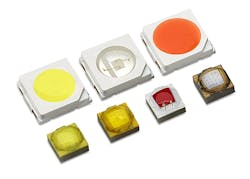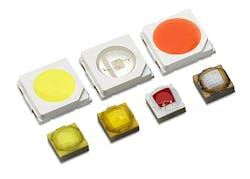Lumileds has delivered new high- and mid-power LEDs for horticultural lighting including a phosphor-converted purple LED that mixes the blue and red wavelengths critical for photosynthesis in a single emitter.
Lumileds has announced the SunPlus portfolio of packaged LEDs intended specifically for horticultural lighting applications including both mid- and high-power components and monochromatic and phosphor-converted options, giving product developers flexibility in luminaire development. Indeed, the new LEDs will support solid-state lighting (SSL) product developments ranging from single-channel luminaire designs that use a new phosphor-converted purple LED that delivers the blue and red spectrum needed for photosynthesis to multichannel developments that can deliver tunable spectrum including broad-spectrum lime and white.
Interested in articles & announcements on horticultural lighting?
The SunPlus LED portfolio is unique in several ways. For starters, Lumileds is binning the LEDs based on a metric called Photosynthetic Photon Flux (PPF) measured in micromoles per second (μmoles/sec). You can read more about the metric in our recent feature article on horticultural lighting. But basically the metric is intended to characterize lighting performance in the plant's Photosynthetically Active Radiation (PAR) spectral band.
The announcement is also unique in that the new products include both the high-power SunPlus 20 packaged LEDs and the mid-power SunPlus 35 LEDs, and in each grouping there are monochromatic and phosphor-converted LEDs. Lumileds has long supported horticultural lighting applications with its broad line of color LEDs as we discussed in a feature article on color LEDs last year. But the new portfolio offers a unique mix of colors and spectral power distributions (SPDs).
As the model number implies, the SunPlus 20 LEDs measure 2×2 mm. And there are five LEDs in the line including monochromatic royal blue (440–460 nm) and deep red (655–675), and far red (720–750 nm) LEDs, and phosphor-converted lime and cool white LEDs. The range of components was intended to support both the single-channel and multichannel tunable approaches to luminaires mentioned earlier. The blue and red LEDs deliver light in regions known to promote photosynthesis, while the white and lime LEDs would be mixed in multichannel designs. Lumileds’ former parent company Philips Lighting recently announced one such tunable horticultural luminaire.
The SunPlus 35 line includes components in plastic packages that measure 3.5×3.5 mm, and perhaps an even more interesting mix of colors and SPDs. Indeed, the aforementioned purple LEDs are an industry first. The LEDs would enable a very simple, single-channel luminaire design to hit the key photosynthesis regions and do so in a way that Lumileds says will result in improved reliability relative to luminaires that mix red and blue emitters.
The purple packaged LEDs utilize a blue pump LED with a red phosphor. Lumileds has developed three versions of the purple with a varying mix of blue spectral energy. An LED with 2.5% blue PPF is meant to encourage stem growth in plants while a 12.5% version targets general growth and a 25% version targets vegetative growth for larger leaves.
Luis Aceña, Lumileds senior manager of business development, explained the presumed benefits of the purple LED relative to individual red and blue emitters. "Our purple LED offerings are distinct in that they are long-lasting, high-efficiency blue LEDs under red phosphor, offering the highest uniformity for consistent growth," said Aceña. "Other companies are combining blue and red LEDs to get purple hues, but this is problematic because red LEDs age faster than blue ones, so the red/blue ratio keeps changing over time, obtaining unreliable growth results."
The mid-power line also includes monochromatic blue (440–460 nm), and phosphor-converted lime and white LEDs. Lumileds did not explicitly address the purpose of the lime and white LEDs, but in our horticultural lighting article linked above, we covered some of that ground. The latest thinking about light recipes indicates that plants, especially fruiting plants where increasing biomass is important, need some energy across the broad visible-light spectrum and also workers need some white light to do their job. And some green energy is needed for plants such as lettuce to develop their characteristic green color.
Indeed, the new SunPlus lines were clearly developed based on research into light recipes. Light recipes will be a recurring theme at our upcoming Horticultural Lighting Conference as we discussed in an article announcing that conference. The conference will take place October 12 in Chicago so there is still time to register and attend.







